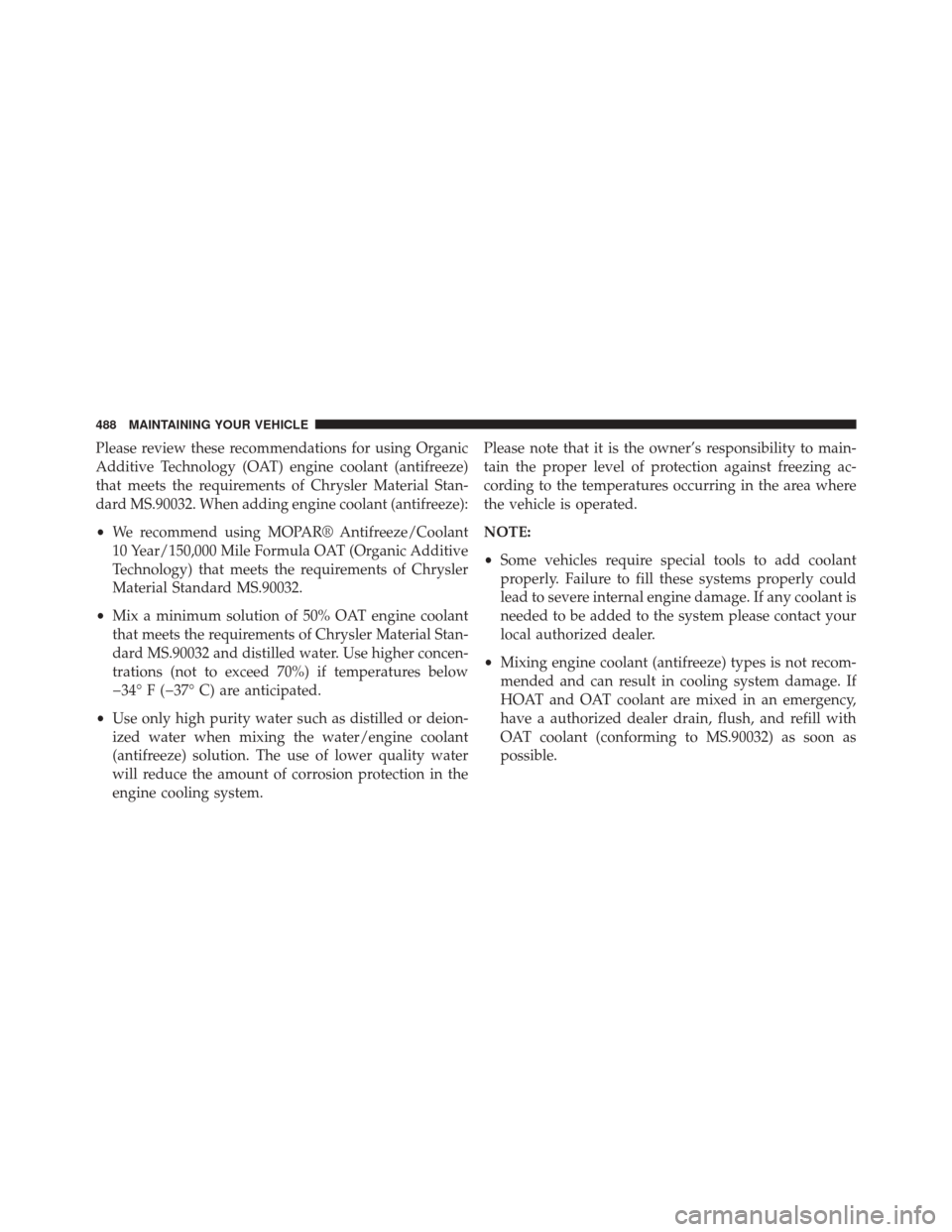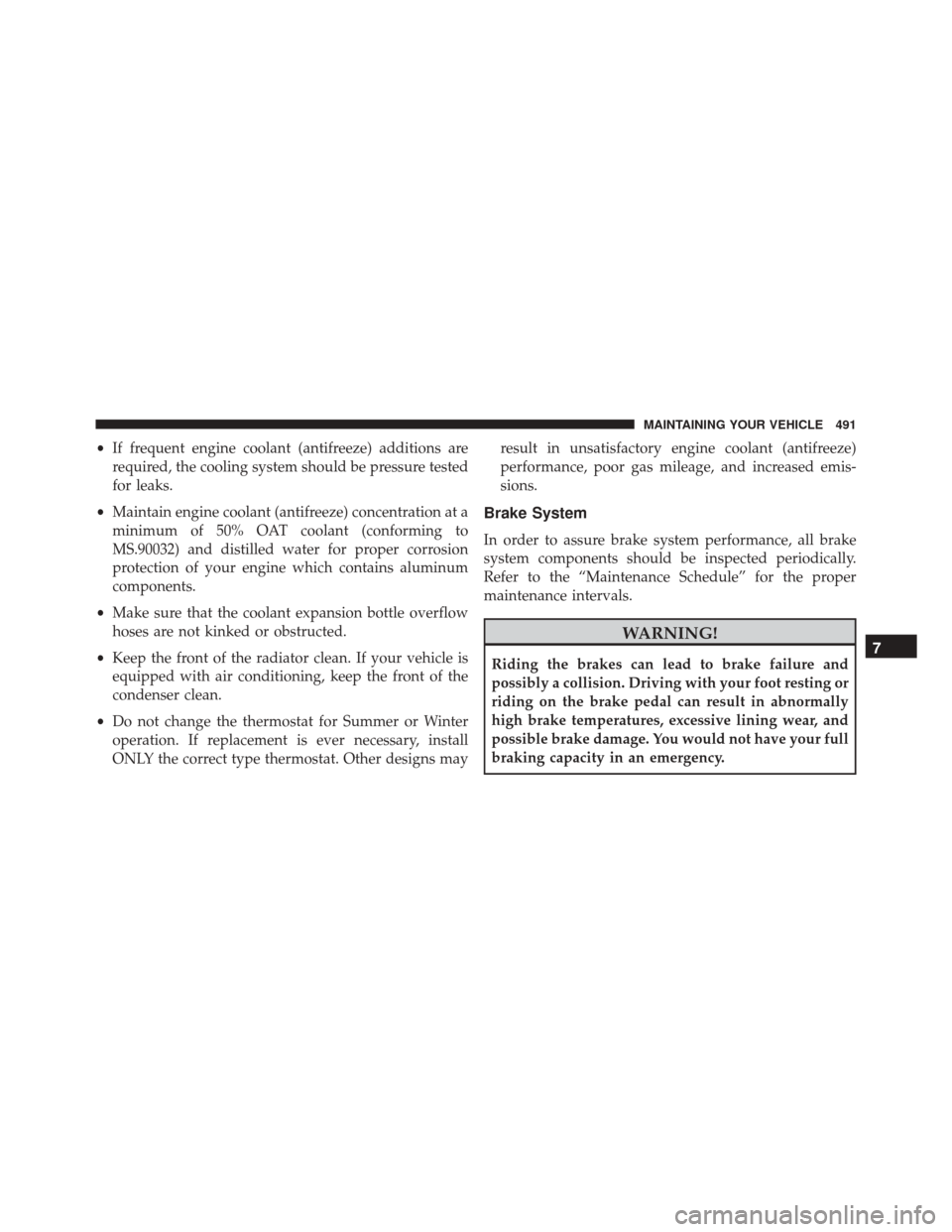2015 DODGE CHALLENGER SRT coolant temperature
[x] Cancel search: coolant temperaturePage 488 of 575

tears, cuts, and tightness of the connection at the bottle
and radiator. Inspect the entire system for leaks.
With the engine at normal operating temperature (but
not running), check the cooling system pressure cap for
proper vacuum sealing by draining a small amount of
coolant from the radiator drain cock. If the cap is sealing
properly, the engine coolant (antifreeze) will begin to
drain from the coolant recovery bottle. DO NOT RE-
MOVE THE COOLANT PRESSURE CAP WHEN THE
COOLING SYSTEM IS HOT.
Cooling System — Drain, Flush And Refill
NOTE:Some vehicles require special tools to add coolant
properly. Failure to fill these systems properly could lead
to severe internal engine damage. If any coolant is
needed to be added to the system please contact your
local authorized dealer. If the engine coolant (antifreeze) is dirty or contains
visible sediment, have an authorized dealer clean and
flush with OAT coolant (antifreeze) (conforming to
MS.90032).
NOTE:
If equipped with the 6.2L Supercharged engine
the intercooler must be vacuum flushed and filled. If any
coolant is needed to be added to the system please
contact your local authorized dealer.
Refer to the “Maintenance Schedule” for the proper
maintenance intervals.
Selection Of Coolant
Refer to “Fluids, Lubricants, And Genuine Parts” in
“Maintaining Your Vehicle” for further information.
486 MAINTAINING YOUR VEHICLE
Page 490 of 575

Please review these recommendations for using Organic
Additive Technology (OAT) engine coolant (antifreeze)
that meets the requirements of Chrysler Material Stan-
dard MS.90032. When adding engine coolant (antifreeze):
•We recommend using MOPAR® Antifreeze/Coolant
10 Year/150,000 Mile Formula OAT (Organic Additive
Technology) that meets the requirements of Chrysler
Material Standard MS.90032.
• Mix a minimum solution of 50% OAT engine coolant
that meets the requirements of Chrysler Material Stan-
dard MS.90032 and distilled water. Use higher concen-
trations (not to exceed 70%) if temperatures below
�34° F (�37° C) are anticipated.
• Use only high purity water such as distilled or deion-
ized water when mixing the water/engine coolant
(antifreeze) solution. The use of lower quality water
will reduce the amount of corrosion protection in the
engine cooling system. Please note that it is the owner’s responsibility to main-
tain the proper level of protection against freezing ac-
cording to the temperatures occurring in the area where
the vehicle is operated.
NOTE:
•
Some vehicles require special tools to add coolant
properly. Failure to fill these systems properly could
lead to severe internal engine damage. If any coolant is
needed to be added to the system please contact your
local authorized dealer.
• Mixing engine coolant (antifreeze) types is not recom-
mended and can result in cooling system damage. If
HOAT and OAT coolant are mixed in an emergency,
have a authorized dealer drain, flush, and refill with
OAT coolant (conforming to MS.90032) as soon as
possible.
488 MAINTAINING YOUR VEHICLE
Page 492 of 575

Coolant Level
The coolant bottle provides a quick visual method for
determining that the coolant level is adequate. With the
engine OFF and cold, the level of the coolant in the bottle
should be between the ranges indicated on the bottle.
The radiator normally remains completely full, so there is
no need to remove the radiator cap unless checking for
coolant freeze point or replacing coolant. Advise your
service attendant of this. As long as the engine operating
temperature is satisfactory, the coolant bottle need only
be checked once a month.
When additional coolant is needed to maintain the
proper level, it should be added to the coolant bottle. Do
not overfill.
Points To Remember
NOTE:When the vehicle is stopped after a few miles/
kilometers of operation, you may observe vapor coming
from the front of the engine compartment. This is nor-
mally a result of moisture from rain, snow, or high
humidity accumulating on the radiator and being vapor-
ized when the thermostat opens, allowing hot engine
coolant (antifreeze) to enter the radiator.
If an examination of your engine compartment shows no
evidence of radiator or hose leaks, the vehicle may be
safely driven. The vapor will soon dissipate.
• Do not overfill the coolant expansion bottle.
• Check the coolant freeze point in the radiator and in
the coolant expansion bottle. If engine coolant (anti-
freeze) needs to be added, the contents of the coolant
expansion bottle must also be protected against freez-
ing.
490 MAINTAINING YOUR VEHICLE
Page 493 of 575

•If frequent engine coolant (antifreeze) additions are
required, the cooling system should be pressure tested
for leaks.
• Maintain engine coolant (antifreeze) concentration at a
minimum of 50% OAT coolant (conforming to
MS.90032) and distilled water for proper corrosion
protection of your engine which contains aluminum
components.
• Make sure that the coolant expansion bottle overflow
hoses are not kinked or obstructed.
• Keep the front of the radiator clean. If your vehicle is
equipped with air conditioning, keep the front of the
condenser clean.
• Do not change the thermostat for Summer or Winter
operation. If replacement is ever necessary, install
ONLY the correct type thermostat. Other designs may result in unsatisfactory engine coolant (antifreeze)
performance, poor gas mileage, and increased emis-
sions.
Brake System
In order to assure brake system performance, all brake
system components should be inspected periodically.
Refer to the “Maintenance Schedule” for the proper
maintenance intervals.
WARNING!
Riding the brakes can lead to brake failure and
possibly a collision. Driving with your foot resting or
riding on the brake pedal can result in abnormally
high brake temperatures, excessive lining wear, and
possible brake damage. You would not have your full
braking capacity in an emergency.
7
MAINTAINING YOUR VEHICLE 491
Page 525 of 575

FLUIDS, LUBRICANTS AND GENUINE PARTS
Engine
ComponentFluid, Lubricant, or Genuine Part
Engine/Intercooler Coolant We recommend you use MOPAR® Antifreeze/Coolant 10 Year/150,000 Mile Formula OAT coolant conforming to MS.90032.
Engine Oil For best performance and maximum protection under all types of operat-
ing conditions, the manufacturer only recommends full synthetic engine
oils.
The manufacturer recommends the use of Pennzoil UltraTM 0W-40 or
equivalent MOPAR® engine oil meeting the requirements of Chrysler Ma-
terial Standard MS-12633 for use in all operating temperatures.
Engine Oil Filter MOPAR® Engine Oil Filter or equivalent.
Spark Plugs We recommend you use MOPAR® Spark Plugs.
Fuel Selection We recommend you use Premium Unleaded 91 Octane or higher.
7
MAINTAINING YOUR VEHICLE 523
Page 555 of 575

Alterations/Modifications, Vehicle...............7
Antifreeze (Engine Coolant) ...............486, 522
Disposal ............................. .489
Anti-Lock Brake System (ABS) ................386
Anti-Lock Warning Light .................221, 388
Appearance Care ........................ .496
Arming System (Security Alarm) ...............18
Auto Down Power Windows ..................38
Automatic Door Locks ......................32
Automatic Headlights ..................... .135
Automatic High Beams .....................136
Automatic Temperature Control (ATC) .......310, 318
Automatic Transmission ..............355, 494, 495
Adding Fluid ...................... .495, 525
Autostick ............................ .362
Fluid and Filter Changes ..................495
Fluid Change ......................... .495
Fluid Level Check ...................... .495
Fluid Type ........................... .525Special Additives
...................... .494
Automatic Transmission Limp Home Mode .......361
Autostick .............................. .362
Auto Unlock, Doors ........................32
Axle Fluid ............................. .525
Axle Lubrication ......................... .525
Battery ................................ .476
Keyless Transmitter Replacement (RKE) ........24
Location ............................. .476
Belts, Seat ...............................93
Body Mechanism Lubrication .................481
B-Pillar Location ......................... .403
Brake Assist System ...................... .389
Brake Control System, Electronic ..............386
Brake Fluid ............................ .525
Brake, Parking .......................... .382
Brakes ................................ .385
Brake System ........................ .385,
491
10
INDEX 553
Page 559 of 575

Engine............................. .465, 466
Air Cleaner .......................... .475
Block Heater ......................... .348
Checking Oil Level ..................... .471
Compartment ......................... .466
Compartment Identification ................465
Coolant (Antifreeze) ..................485, 523
Cooling ............................. .485
Exhaust Gas Caution ..................92, 429
Fails to Start .......................... .346
Flooded, Starting ...................... .346
Fuel Requirements ..................... .426
Jump Starting ......................... .451
Oil .......................... .471, 522, 523
Oil Change Interval ..................... .471
Oil Filler Cap ......................... .472
Oil Selection ...................... .472, 522
Oil Synthetic ......................... .473
Overheating .......................... .438Starting
............................. .341
Temperature Gauge ..................... .221
Engine Oil Viscosity ...................... .472
Enhanced Accident Response Feature ............64
Entry System, Illuminated ....................21
Ethanol ............................... .427
Event Data Recorder ........................67
Exhaust Gas Caution ....................92, 429
Exhaust System ....................... .92, 482
Exterior Folding Mirrors ....................109
Exterior Lighting ......................... .134
Exterior Lights ............................95
Filler Location Fuel ....................... .430
Filters Air Cleaner .......................... .475
Air Conditioning ....................320, 479
Engine Oil ........................ .475, 523
Engine Oil Disposal .....................474
10
INDEX 557
Page 561 of 575

Gasoline (Fuel).......................... .426
Gasoline, Reformulated .....................426
Gauges Coolant Temperature .....................221
Fuel ................................ .221
Odometer ............................ .221
Speedometer ......................... .221
Tachometer ........................... .221
Gear Ranges ............................ .356
General Information ...................... .425
Glass Cleaning .......................... .501
Gross Axle Weight Rating ...................433
Gross Vehicle Weight Rating ..................433
GVWR ................................ .433
Hazard Driving Through Flowing, Rising, or Shallow
Standing Water ........................ .378
Hazard Warning Flasher ....................438 Headlights
............................. .520
Automatic ........................... .135
Cleaning ............................ .500
Delay ............................... .137
High Beam/Low Beam Select Switch .........140
Lights On Reminder .....................138
On With Wipers .....................136, 146
Passing ............................. .140
Switch .............................. .134
Time Delay ........................... .137
Washers ............................. .482
Headlight Washers ....................... .482
Head Restraints ......................... .129
Head Rests ............................. .129
Heated Mirrors ...........................111
Heater, Engine Block ...................... .348
High Beam/Low Beam Select (Dimmer) Switch . . . .140
Hill Start Assist .......................... .390
HomeLink® (Garage Door Opener) ............195
10
INDEX 559